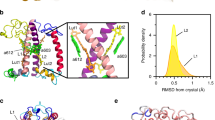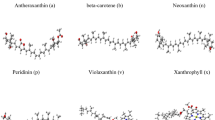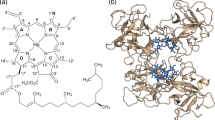Abstract
CHLOROPHYLL has a unique characteristic in being photo-oxidized or photo-reduced by reactants which can serve as electron acceptors or donors to light-activated chlorophylls1. The photo-reduction of chlorophyll occurs when ascorbic acid is the reductant2. Quinones act as electron acceptors for the photo-oxidation of chlorophyll3, but hydroquinones have not been shown to function as electron donors to the excited chlorophyll. It is known that hydroquinones are photo-oxidized by oxygen in chlorophyll a and b solutions4. The work recorded here consists of an experimental investigation of the direct interaction between excited chlorophyll and hydroquinone. The effect of oxygen on this system is also shown in this communication.
This is a preview of subscription content, access via your institution
Access options
Subscribe to this journal
Receive 51 print issues and online access
$199.00 per year
only $3.90 per issue
Buy this article
- Purchase on Springer Link
- Instant access to full article PDF
Prices may be subject to local taxes which are calculated during checkout
Similar content being viewed by others

References
Livingston, R., Quart. Rev., 14, 174 (1960).
Krasnovsky, A. A., Ann. Rev. Plant. Physiol., 11, 363 (1960).
Tollin, G., and Green, G., Biochim. Biophys. Acta, 60, 524 (1962); 66, 308 (1963).
Okayama, S., and Chiba, Y., Nature, 205, 172 (1965).
Zscheile, F. P., and Comar, C. L., Bot. Gaz., 102, 463 (1941).
Fujimori, E., and Livingston, R., Nature, 180, 1036 (1957).
Calvin, M., in Biophysical Science—A Study Program, edit. by Oncley, J. L., 157 (J. Wiley and Sons, Inc., New York, 1959).
Livingston, R., and Stockman, D., J. Phys. Chem., 66, 2531 (1962).
Vernon, L. P., and Shaw, E. R., Biochemistry, 4, 133 (1965).
Ke, B., Vernon, L. P., and Shaw, E. R., Biochemistry, 4, 137 (1965).
Schenck, G. O., Naturwiss., 40, 205, 229 (1953).
Livingston, R., and Owens, K. E., J. Amer. Chem. Soc., 78, 3301 (1956).
Claes, H., Biochem. Biophys. Res. Comm., 3, 585 (1960); Z. Naturforsch., 16, 446 (1961).
Author information
Authors and Affiliations
Rights and permissions
About this article
Cite this article
FUJIMORI, E., TAVLA, M. Interaction between Chlorophyll and Hydroquinone. Nature 208, 78–79 (1965). https://doi.org/10.1038/208078a0
Published:
Issue Date:
DOI: https://doi.org/10.1038/208078a0
Comments
By submitting a comment you agree to abide by our Terms and Community Guidelines. If you find something abusive or that does not comply with our terms or guidelines please flag it as inappropriate.


